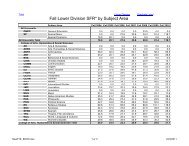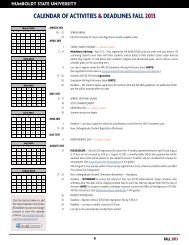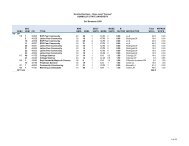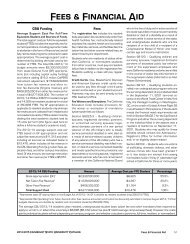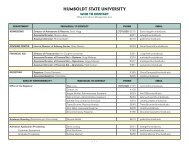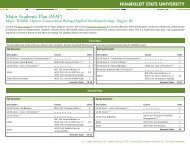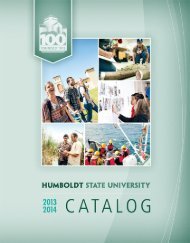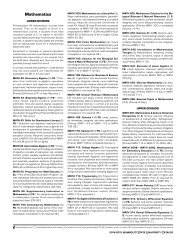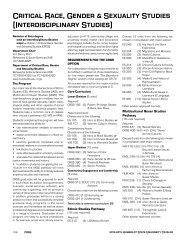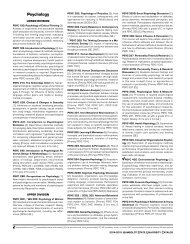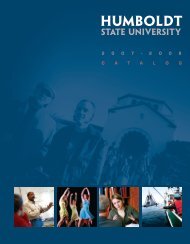2011-12 Academic Year - Bad Request - Humboldt State University
2011-12 Academic Year - Bad Request - Humboldt State University
2011-12 Academic Year - Bad Request - Humboldt State University
Create successful ePaper yourself
Turn your PDF publications into a flip-book with our unique Google optimized e-Paper software.
while intoxicated. Penalties for a first drunk driving<br />
offense include attending an alcohol/drug<br />
program, fines up to $1000, up to six months<br />
in jail, and driver’s license suspension up to six<br />
months. Second offenses are punishable by<br />
fines up to $1000, imprison ment up to one year,<br />
driver’s license suspension up to 18 months, and/<br />
or a required drug/alcohol program of up to 30<br />
months. Third and fourth offens es carry similar<br />
sanctions, plus three- and four-year revocations of<br />
driver’s license, respectively. Driving privileges are<br />
suspended for one year for refusing to submit to a<br />
blood alcohol test, for two years if there is a prior<br />
offense within seven years, and for three years<br />
with three or more offens es within seven years.<br />
Under California law, first offenses involving the<br />
sale or possession for sale of ampheta mines,<br />
barbiturates, codeine, cocaine, Demerol, her o in,<br />
LSD, mescaline, methadone, meth am phet amine,<br />
morphine, PCP, peyote, Quaalude, psi locybin, and<br />
marijuana are felonies carrying prison terms<br />
of seven years or more. Manufacture of illegal<br />
drugs may result in prison terms of 20 years or<br />
more. Penalties are more severe for offenses<br />
involving manufacture or distribution of illegal<br />
drugs by convicted felons and for distribution<br />
within 1000 feet of a school or university, within<br />
100 feet of a recreational facility, to anyone in<br />
prison or jail, to anyone under 18 by anyone over<br />
18, or to a pregnant woman. Personal property<br />
may be seized if it contains drugs or was used<br />
in a drug transaction. The illegal possession of<br />
most of these drugs is also a felony (marijuana<br />
may be a felony or misdemeanor depending upon<br />
the amount involved), carrying maximum prison<br />
sentences of up to sev en years.<br />
Sources: Printed with permission from <strong>University</strong><br />
of California, Davis—materials prepared for<br />
members of Bay Area Consortium of College and<br />
<strong>University</strong> Prevention Programs (Bac cupp) by<br />
Linda Cherry, © 1990; Federal Register, Vol 55,<br />
Number 159, p 33588 and 33590; mater ials<br />
prepared by California Department of Justice<br />
Training Center (classifications of drug offenses);<br />
and California and Federal legislation, regulations,<br />
and case law.<br />
Alcohol & Other Drugs:<br />
Education & Prevention Services<br />
& Programs<br />
A key element of alcohol and drug abuse prevention<br />
is students working with other students to<br />
create healthy norms of behavior on campus.<br />
Through the Health Education and Promotion<br />
Program in the Student Health & Counseling<br />
Center, students can get involved in bringing vital<br />
health outreach and leadership on a variety of<br />
health topics (including substance use) to the<br />
campus community. Contact the university health<br />
educator at 707-826-5<strong>12</strong>3 for more information.<br />
Many self-help groups meet both on campus<br />
and in the community. Check the bulletin board<br />
outside the health educa tor’s office and counseling<br />
center on the second floor of the Student<br />
Health & Counseling Center for exact names,<br />
places, and times. There are many community<br />
resources (public, private nonprofit, and private<br />
<strong>2011</strong>-20<strong>12</strong> <strong>Humboldt</strong> <strong>State</strong> <strong>University</strong> Catalog<br />
for profit) available. Resources, both on and off<br />
campus, include:<br />
On-Campus:<br />
Counseling & Psychological<br />
Services ..........................................707-826-3236<br />
Student Health Center ............................826-3146<br />
Off-Campus:<br />
Alcoholics Anonymous ......... (24 hrs) 442-0711<br />
Al-Anon and Al-Ateen ...............................443-1419<br />
Alcohol/Drug Care<br />
Services (DETOX) .................................445-3869<br />
American Cancer Society ......................442-1436<br />
Codependents Anonymous ...................445-3833<br />
Crossroads Residential<br />
Program ...................................................445-0869<br />
<strong>Humboldt</strong> Alcohol Recovery<br />
Center .......................................................443-4237<br />
Health Department Tobacco<br />
Education .................................................268-2132<br />
Health Department Free &<br />
Anonymous HIV/AIDS<br />
Testing .......................................................268-2132<br />
Healthy Moms ............................................441-5220<br />
<strong>Humboldt</strong> County Alcohol &<br />
Other Drug Programs ......................445-6250<br />
<strong>Humboldt</strong> Recovery Center ..................443-4237<br />
<strong>Humboldt</strong> Women for Shelter .............444-9255<br />
24-hour Crisis Line .............................443-6042<br />
Mothers Against Drunk Driving ..........443-5072<br />
Narcotics Anonymous ............................444-8645<br />
Open-Door Clinic Smoking<br />
Cessation .................................................826-8610<br />
PACE Program ...........................................445-7444<br />
St. Joseph Hospital Family<br />
Recovery Services ...............................445-9251<br />
Singing Trees Recovery Center 800-344-3799<br />
United Indian Health Services .............825-5000<br />
Health Risks Associated with<br />
Substance Abuse<br />
Substance abuse can cause extremely serious<br />
health and behavioral problems, including shortand<br />
long-term effects upon the body and mind. The<br />
physiological and psychological responses differ<br />
according to the chemical ingested. Although<br />
chronic health problems are associated with longterm<br />
substance abuse, acute and traumatic reactions<br />
can occur from one-time and moderate use.<br />
The health risks associated with each of five major<br />
classifications of controlled/illegal substances<br />
are summarized below. In general, alcohol and<br />
drugs are toxic to the body’s systems. In addition,<br />
contaminant poisonings often occur with illegal<br />
drug use, and mixing drugs, or using “counterfeit”<br />
substances, can also be lethal. Human Im mu nodeficiency<br />
Virus (HIV or AIDS), other sexually transmitted<br />
infections, rape, unwanted pregnancies,<br />
injuries, accidents, and violence can result from<br />
alcohol abuse or drug use. In addition, substance<br />
abuse impairs learning ability and performance.<br />
Acute health problems may include heart attack,<br />
stroke, and sudden death, which, in the case of<br />
drugs such as cocaine, can be triggered by firsttime<br />
use. Long lasting health effects of drugs and<br />
alcohol may include disruption of normal heart<br />
rhythm, high blood pressure, blood vessel leaks<br />
in the brain, destruction of brain cells and perma-<br />
nent memory loss, infertility, impotency, immune<br />
system impairment, kidney failure, cirrhosis of<br />
the liver, and pulmonary (lung) damage. Drug use<br />
during pregnancy may result in miscarriage, fetal<br />
damage and birth defects causing hyperactivity,<br />
neurological abnormalities, developmental difficulties,<br />
and infant death.<br />
Alcohol. As many as 360,000 of the nation’s <strong>12</strong><br />
million undergraduates will ultimately die from<br />
alcohol-related causes while in school. This is more<br />
than the number who will get MAs and PhDs combined.<br />
Nearly half of all college students binge drink<br />
(binge drinking is defined as five or more drinks at<br />
a time for men, four or more drinks for women).<br />
On campuses where binge drinking is rampant<br />
(where more than 70% of students binge drink),<br />
the vast majority of students have experienced<br />
one or more problems as a result of their peers’<br />
binge drinking. These problems include phy sical<br />
assault, sexual harassment, and impaired sleep<br />
and study time. Alcohol on college campuses is a<br />
factor in 40% of all academic problems and 28%<br />
of all dropouts.<br />
Long-term abuse of alcohol results in ulcers,<br />
gastritis, pan creatitis, liver disease, hepatitis,<br />
and cirrhosis, and is associated with cancers of<br />
the digestive tract. Chronic heavy consump tion<br />
can lead to stroke, hypertension, heart dis ease,<br />
anemia, susceptibility to tuberculosis, gastrointestinal<br />
bleeding, impotence and fertility loss. Episodic<br />
binge drinking can cause toxic reactions leading<br />
to death when large amounts are consumed or<br />
when alcohol is combined with other drugs. The<br />
most common negative health consequences<br />
from occasional drinking are trauma-related (accidents<br />
and violence), and involve both the drinker<br />
and nondrinking victims.<br />
Sources: Wechsler, Henry, et al. “Health and<br />
Behavioral Consequences of Binge Drinking<br />
in College,” Journal of the American Medical<br />
Association, Vol 272, Number 21 1994), p<br />
1672-1677; Eigan, Lewis, “Alcohol Practices,<br />
Policies and Potentials of Amer ican Colleges<br />
and Universities,” An OSAP White Paper, Office<br />
for Substance Abuse Prevention, Rock ville, MD,<br />
February 1991; Anderson, David, “Breaking the<br />
Tradition on College Campuses: Reducing Drug<br />
and Alcohol Misuse,” George Mason <strong>University</strong>,<br />
Fairfax, VA 1994.)<br />
Other Depressants. These drugs include narcotics<br />
(for example, opium, heroin, morphine, codeine,<br />
and synthetic opiates) and sedative-hypnotics and<br />
antianxiety medications (for ex ample, Nembutal,<br />
Seconal, Quaalude, Mil town, Equanil). All are<br />
central nervous depressants that slow down<br />
physical and psychological re sponses. The most<br />
serious risk is toxic reaction, or overdose, which<br />
causes death when respiratory, cardiac, and<br />
circulatory systems slow down and cease to function.<br />
Sedatives and antianxiety drugs can cause<br />
temporary psychosis, hallucinations, paranoid<br />
delusions, interference with short-term memory,<br />
impaired judgment and motor performance,<br />
increased angry outbursts, and permanent neurological<br />
damage.<br />
Stimulants. These drugs include amphetamines,<br />
methamphetamines, and cocaine (crack). Stim-<br />
Fine Print<br />
275



